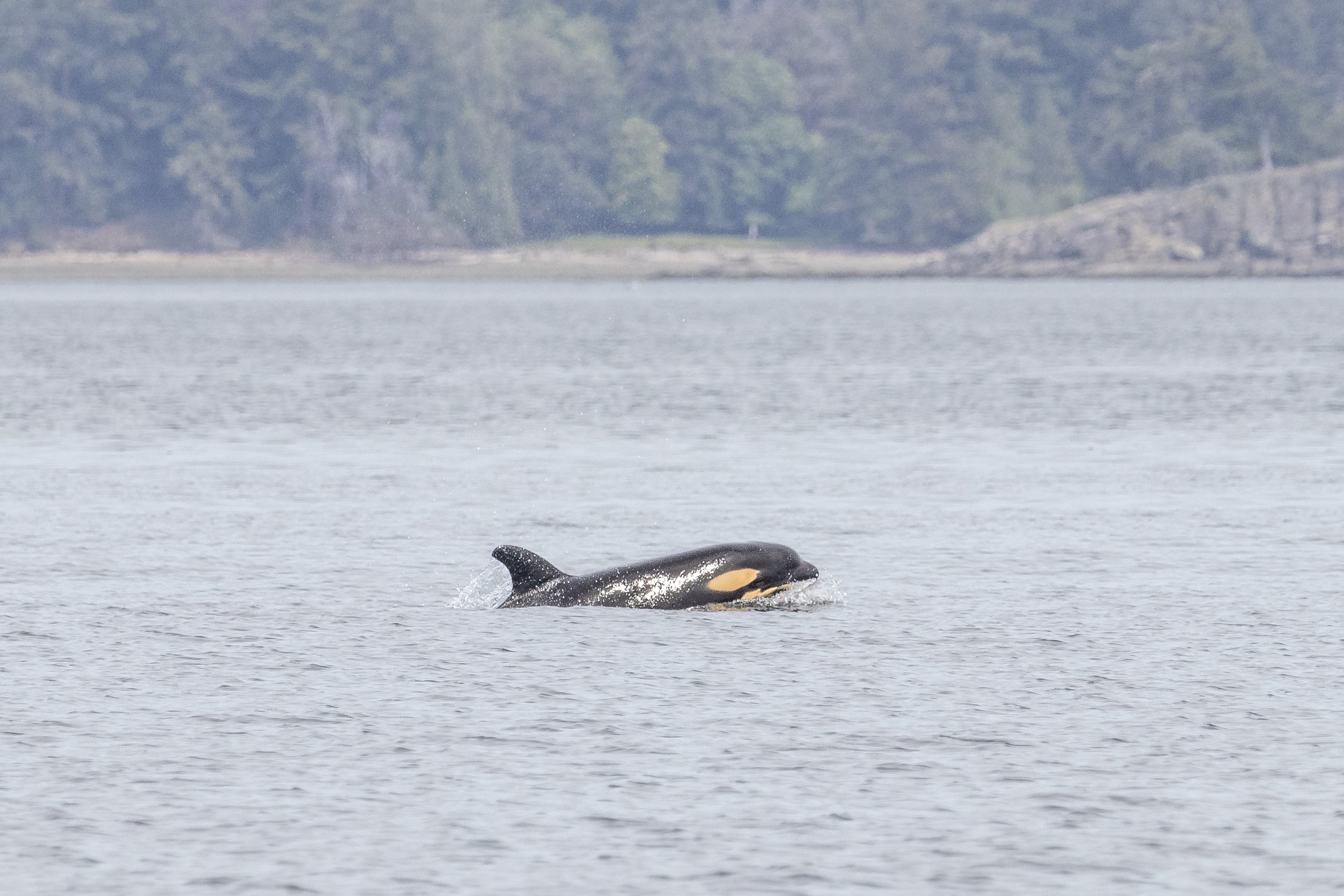May 14, 2024 - T124As and the Mystery Calf
We had our open boat Cascadia out today! We pushed off the dock and headed down through Dodd Narrows and into the Gulf Islands in search of whales. Even if it’s windy and wavy out in the more open body of water known as the Strait of Georgia, we can always count on calm seas in the islands! Today was no different, the inland channels were like glass as we headed towards a report of orcas in between Mayne Island and North Pender Island in a waterway known as Navy Channel. When we got on scene, there were three whales closer to us, and three across the channel. We pulled out our ID guides and identified them as the T124As!
T124A Kittiwake (1984) ♀
T124A4 Sabio (2010) ♀
T124A4A (2021) ♀
T124A6 Kasuun (2016) ♂
T124A7 (2021) ♀
T124A1A (2024)
These whales are pretty common visitors to the Salish Sea. They frequent the waters in our range, and it’s always nice to see familiar fins! Especially when there are so many calves in this pod. One little calf (T124A1A) in particular has been quite the mystery. Originally, they were seen with Kittiwake’s oldest (T124A1 Bonapartes (1996) ♀) who wasn’t seen today! Instead, they were glued to Sabio’s side. So that leaves us questioning, who does this calf belong to? Sabio or Bonapartes? Only time will tell!
These guys were travelling when we first caught up to them. Orcas typically travel around 5 to 10 km per hour, but can reach speeds of 50 km per hour if they really want to. In one day, orcas can cover over 100 km. Even with young calves in tow! Transient Killer Whales, also known as Bigg’s, are named so because they travel around quite a lot. Their range reaches as far north as Alaska, and as far south as California. Transient orcas do not migrate like humpback whales, there is almost no pattern to their movements. However, there are certain parts of Vancouver Island that pods visit at certain times of the year. For example, the T124As like to visit the Saanich Inlet in January with some friends, and they visit the area within our range for a while in May!
After watching them travel for a while, they started to change direction. If that happens, it can indicate that they’re hunting! Transients are mammal-eating killer whales, so they eat seals, sea lions, porpoises, and even dolphins if they’re feeling energetic enough. We watched Kittiwake and her family hunt, and then they started to get excited. They did some tail slapping, one spyhopped, and the youngest was having an absolute blast.
As per regulations, we watched these guys for an hour and then turned around to go home. We were pretty far south! We stopped along the way for some seals, which we also love to call rock sausages because they’re so round and we commonly see them hauled out on rocks above the tideline. We also stopped at Harmac pulp mill, one of our favorite spots to see California Sea Lions. These guys like to make a lot of noise, barking at everything from boaters to each other!
After watching the sea lions, it was time to return to the harbour after a successful whale watch!
Photos today were taken by Marine Naturalist Lucy Willis.
T124A1A, the little calf that is confusing us! who do you belong to?
T124A4A and T124A1A, with the tip of Sabio’s fin visible. T124A4A is old enough to receive a nickname but doesn’t have one yet.
T124A4A close to mom Sabio.
T124A4A and T124A4 Sabio.
T124A1A and T124A4 Sabio. Look at Sabio’s notches! They leave lines in her fin, wonder what those are?
T124A4A and T124A4 Sabio. Sabio and her kid (s?) were being wonderfully photogenic today.
T124A1A. This one sure is spunky, just like all T124A calves!
T124A4 Sabio. We can use dorsal fins and saddle patches to identify an orca, but the eyepatches are also different, especially the patterns at the front.
T124A6 Kasuun and T124A1A. Those rake marks on Kasuun are likely from sea lions. They fight back when orcas hunt them.
T124A7 and T124A Kittiwake. Like T124A4A, she doesn’t have a nickname yet. We can’t wait for her to get one!
Front to back: T124A7, T124A4 Sabio, and T124A Kittiwake.
T124A4 Sabio, T124A1A, and T124A Kittiwake. They grouped up right before they started hunting.
T124A Kittiwake sporting some new wounds.
T124A6 Kasuun on the right while T124A4 Sabio spyhops!
One of the T124As surfacing towards us while Kittiwake surfaces away. This is a pretty good indication of hunting.
Kittiwake tail slapping. Orcas will celebrate after a hunt because they’re happy to have full bellies.
T124A4 Sabio and T124A1A attempting a spyhop. They’re trying their best!
Little tail flick from little T124A1A!
T124A1A having too much fun.
Seals’ fur camouflages perfectly to the rocks they haul out on. How many seals can you count?
A harbour seal looking thoroughly unimpressed with us.
Harbour seals having a good look at us while we watch them.
While the younger seals are skittish around us, the older ones know we’re just going to say hi and then go on our way.
Do you think this one knows how beautiful they are?
A California Sea Lion using another as a pillow.
Well these two seem happy. The one on top is actually a Steller Sea Lion! You can tell because they’re lighter in color and considerably bigger.


























